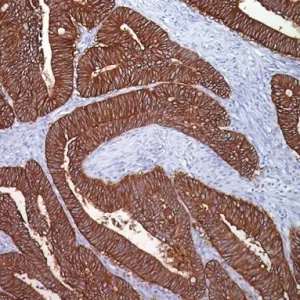Description
Neurotrophic tyrosine receptor kinase (NTRK) proto-oncogenes NTRK1, NTRK2, and NTRK3 (that encode TRK A, TRK B, and TRK C proteins, respectively) may form gene fusions through their kinase domains, driving tumor development (1). TRK A is activated by nerve growth factor (NGF), TRK B by brain-derived neurotrophic factor (BDNF) or neurotrophin-4 (NT-4), and TRK C by neurotrophin- 3 (NT-3) (2).
NTRK fusions are characteristic of a few rare types of cancer, such as secretory carcinoma of the breast or salivary gland and infantile fibrosarcoma, but they are also infrequently seen in some common cancers, such as melanoma, glioma and carcinomas of the thyroid, lung and colon (3,4). Pan TRK immunohistochemical staining to detect NTRK fusions has become increasingly important as TRK inhibitors, Larotrectinib and Entrectinib, have received regulatory approval and have demonstrated a high response rate in patients with NTRK fusions (3,5).
SPECIFICATIONS
Specifications
| INTENDED USE | IVD |
|---|---|
| FORMAT | Concentrate, ONCORE Pro, Predilute, Q Series, UltraLine |
| VOLUME | 0.1 ml, 1.0 ml, 6.0 ml, 60 Tests, 7 ml |
| SOURCE | Rabbit Monoclonal |
| CLONE | RM423 |
| SPECIES REACTIVITY | Human; others not tested |
| ISOTYPE | IgG |
| POSITIVE CONTROL | Brain |
DATASHEET & SDS
REFERENCES
1. Hechtman JF, Benayed R, Hyman DM, et al. Pan-Trk immunohistochemistry is
an efficient and reliable screen for the detection of NTRK fusions. Am J Surg Pathol.
2017;41(11):1547-1551.
2. Cocco E, Scaltriti M, Drilon A. NTRK fusion-positive cancers and TRK inhibitor
therapy. Nat Rev Clin Oncol. 2018;15(12):731-747.
3. Solomon JP, Linkov I, Rosado A, et al. NTRK fusion detection across multiple
assays and 33,997 cases: diagnostic implications and pitfalls. Mod Pathol.
2020;33(1):38-46.
4. Solomon JP, Benayed R, Hechtman JF, Ladanyi M. Identifying patients with
NTRK fusion cancer. Ann Oncol. 2019;30(Suppl_8): viii16-viii22.
5. Drilon A. TRK inhibitors in TRK fusion-positive cancers. Ann Oncol.
2019;30(Suppl_8): viii23-viii30.
6. Center for Disease Control Manual. Guide: Safety Management, NO. CDC-22,
Atlanta, GA. April 30, 1976 “Decontamination of Laboratory Sink Drains to Remove
Azide Salts.”
7. Clinical and Laboratory Standards Institute (CLSI). Protection of Laboratory
Workers from Occupationally Acquired Infections; Approved Guideline-Fourth
Edition CLSI document M29-A4 Wayne, PA 2014.









Reviews
There are no reviews yet.